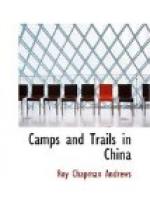I found two great troupes of the monkeys running along the opposite river bank. The first herd was climbing up the almost perpendicular rock walls, swinging on the bushes and sometimes almost disappearing in the tufts of grass. I could not approach nearer than one hundred and fifty yards and did some very bad shooting at the little beasts, but a running monkey at that distance is a pretty uncertain mark, and it requires a much better shot than I am to register more hits than misses. I did kill two, but both dropped into the river and promptly sank, so that I gave it up.
Less than a half mile farther on another and larger troupe appeared among the boulders just at the water’s edge. Profiting by my experience, I kept out of sight among the bushes and watched the animals play about until one hopped to a rock and sat quietly for an instant. I got six in this way, but we were able to recover only three of them from the water.
Heller shot three muntjac at Hui-yao, besides the doe which he killed on the first day. One of the largest bucks had a pair of beautiful antlers three and one half inches long from the burr to the tip. The skin-covered projections, or pedicels, of the frontal bone, from the summits of which the antlers grow, measured two and one-half inches from the skull to the burrs. Evidently the muntjac are somewhat irregular in shedding for, although they were all in full summer pelage, two already had lost their antlers while the other had not. I can think of no more delicious meat than the flesh of these little deer and they seem to be as highly esteemed by the English sportsmen of India as they are by the foreigners of China.
I did not see a muntjac while at Hui-yao, but was fortunate in killing a splendid coal-black serow which represents a sub-species new to science; although the natives said that serow were known to occur in the thick jungle on the south side of the river, none had been seen for years. Heller and I had gone to this part of the gorge to hunt for a troupe of monkeys which he had located on the previous day. We had separated, Heller keeping close to the water while I skirted the cliffs near the summit not far from the road which led through the pine forest.
I was walking just under the rim of the gorge when suddenly with a snort a large animal dashed out of a thicket below and to the left. I caught a glimpse of a great coal-black body and a pair of short curved horns as the beast disappeared in a shallow gully, and realized that it was a serow. A few seconds later it reappeared, running directly away from me along the upper edge of the gorge. I fired and the animal dropped, gave a convulsive twist, rolled over, and plunged into the canon.
As the serow disappeared we heard a chorus of excited yells from below, and it was evident that some natives near the water had seen it fall. I had slight hope that they might have rescued it from the river, but my heart was heavy as we worked along the cliff trying to find a place where it was possible to descend. A wood cutter whom we discovered a short distance away guided us down a trail so steep that it seemed impossible for a human being to walk along it, and in proof I slid the last half of the way to the rocks at the river’s edge, narrowly escaping a broken neck.




